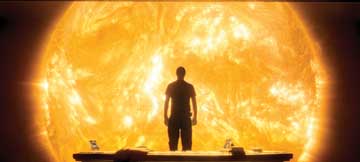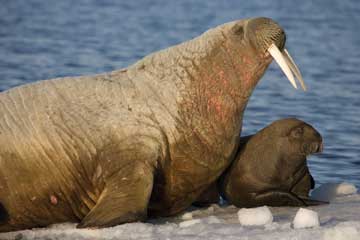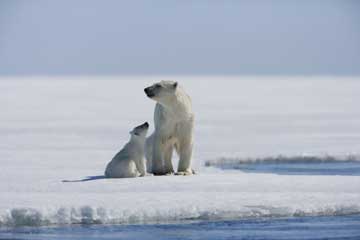|
GEOMEDIA
Check out the latest On the Web links, your connection to earth science friendly Web sites. The popular Geomedia feature is now available by topic.
MOVIES: Saving Our Sun: A Review of Sunshine
MOVIES: Change Is in the Air: A Review of Arctic Tale
Saving Our Sun: A Review of Sunshine
 TM and © 2007 Twentieth Century Fox and Dune Entertainment LLC |
| In the film Sunshine, an astronaut on a risky mission to save Earth 50 years from now gazes into the sun. |
In Sunshine, director Danny Boyle, who last used a deadly zombifying disease to explore all-too-human evil in 28 Days Later, combines cutting-edge computer graphics with well-trodden questions about science’s ambitions to save humankind to make a beautifully imagined, yet old-fashioned sci-fi/horror flick. What is surprising, however, is that the plot turns out to be based on an intriguing idea from theoretical physics, even though that is never actually discussed in the movie itself.
Bypassing exposition, the film jumps right into the story with an apparently far-out scientific supposition (the sun is dying just 50 years from now; go with it). It soon becomes apparent, however, that at its core Sunshine is less interested in how to fix the sun than in a basic philosophical question familiar to many a sci-fi fan: Is breathing new life into a dying sun, and thereby altering the true course of nature, really just unforgivable hubris? That question is underscored by the expeditions themselves — both hopeful/doomed missions are named Icarus, after the Greek legend of the boy who flew too close to the sun on makeshift, borrowed wings.
Visually, the film is stunning, with many awe-inspiring computer-generated images of the fiery, mottled surface of the sun, both life-giving and deadly. Those images often fill the screen, whether serving as a brilliant backdrop to the small black dot of Mercury as it passes in front of the massive orb, or reflected in the spaceship’s (fragile-looking) heat shield or the crew’s shiny gold Mylar spacesuits. And the omnipresent danger the astronauts are in, carefully balanced between the cold darkness of space and the burning hotness of the sun, creates near-constant tension.
As presented in the movie, however, the actual scientific plan to save the sun is simultaneously highly dramatic and rather vague. It is 2057, and the dying sun means that Earth is rapidly entering an ice age. In a desperate last-ditch effort, the entire planet has pooled its fissionable material into two “payloads” — or rather, bombs — bundled onto two subsequent space missions. Icarus I had set out in 2050, intending to deliver its payload straight into the heart of the star and create an explosion that would (theoretically) “restart” the sun and get things rolling again. Seven years later, with no sign of Icarus I’s fate, Icarus II is now on its way with the second payload, and humankind’s last chance to save itself.
Why the sun is dying only 50 years from now (about 5 billion years ahead of schedule) is never explicitly discussed in the movie. (Nor is its effect on Earth: For most of the film, Earth, and the danger it’s in, remain abstract, with only a hint of what’s been happening back home in a brief glimpse of a frozen-over Sydney, Australia.) As it turns out, however, the film’s creators, with the help of their scientific advisor, physicist Brian Cox of the particle physics laboratory CERN in Geneva, Switzerland, did devise a backstory that relies heavily on theoretical physics.
In a nutshell, the sun isn’t dying due to the normal life span of a star, in which, after billions of years, it runs out of hydrogen to burn into helium, starts fusing helium into heavier elements like carbon and iron, swells up to become a red giant and then finally collapses to become a white dwarf (see story, this issue). Instead, the sun is being eaten from the inside out by a massive, supersymmetric atomic nucleus called a Q-ball. Don’t laugh: This is a concept that theoretical physicists take quite seriously.
In physics, the theory of supersymmetry (first proposed in 1973) holds that every particle of matter we have observed also has an as-yet-undetected “partner” particle. For example, each quark that helps make up a proton or neutron has a counterpart “squark.” Although short-lived on their own, squarks that formed in the early universe may have clumped together to form massive, heavy nuclei called Q-balls, which could survive much longer (scientists at CERN are currently using the lab’s giant particle accelerator to search for such supersymmetric particles). In the film’s production diary (found on its Web site at www.foxsearchlight.com/sunshine), Cox explains that if a Q-ball were to drift into ordinary matter, such as a star, the ordinary particles in that matter would spontaneously convert to squarks, essentially ripping the star apart.
Hence the bomb plan: To dismantle a Q-ball into individual squarks, which will then decay harmlessly, you need temperatures similar to those just after the Big Bang. Therefore, Cox said, if you could recreate a mini-Big Bang inside the star (using a special kind of bomb made of dark matter and uranium), you might be able to disrupt that interaction and ultimately save the star. Maybe.
Well, it sounds good, anyway. You don’t need to know any of this to enjoy the movie in its own right (if you like fast-paced, tense, well-acted sci-fi/horror flicks), or to ponder the philosophical question at its heart. The director wisely leaves this level of scientific detail completely out of the film, concentrating on building tension through the immediate dangers to his characters, both external and internal. Indeed, there is an impending sense of inevitable doom throughout; even if everything goes according to plan, saving the sun has always been a long shot.
But even after the movie ends and the credits have rolled, knowing that it’s not completely fiction — that there may be more than one way to kill a star — certainly adds a little extra shiver.
Links:
"Reaching for the stars in planet formation," Geotimes, October 2007
www.foxsearchlight.com/sunshine
Change Is in the Air: A Review of Arctic Tale
 Paul Nicklen |
| Arctic Tale, a new film by National Geographic and Paramount Classics, follows the lives of a young polar bear and walrus as they grow up in a changing Arctic. |
 Paul Nicklen |
Imagine being a small child living in one of the roughest and coldest climates on the planet. Life is hard already, but sudden changes in the environment that you cannot explain cause your food supplies to dwindle. Left without any resources, your mother is forced to abandon you as a young teenager because she can no longer provide for the both of you.
Such is the fate of Nanu, a fuzzy polar bear cub with big brown eyes and one of the main stars in the latest Paramount Classics and National Geographic film, Arctic Tale. Adam Ravetch and Sarah Robertson, a husband-and-wife filmmaking team, have employed a new and unusual approach to documentary storytelling to spin this gripping tale about life in the rapidly changing Arctic. Using two personified live animals, Nanu, a polar bear, and Seela, a sleek walrus pup, the filmmakers tell a story about climate change as seen through the eyes of those who are most affected by it: the Arctic animals.
Although the overall story is fictional, assembled from footage that Ravetch and Robertson shot during more than a decade in the Arctic, it documents the reality that the pair witnessed there. Narrated by Queen Latifah, the film follows Nanu and Seela — composite characters pieced together from clips of many individual animals — for eight years, illustrating the various aspects of the animals’ lives that are touched by climate change.
During Nanu’s and Seela’s toddler years, Arctic life is normal. Seela cuddles with her herd on an ice float after gobbling up thousands of sand mussels. The polar bears leave their summer quarters in the coastal regions and head out onto the frozen Arctic Ocean to hunt. Astonishing images show Nanu’s mother catching a seal swimming beneath the ice surface — unsuspecting and therefore easy prey for the bear. After a few years, the conditions change. The sea ice that Nanu and his relatives depended on begins to soften and thaws earlier than usual. As their hunting grounds flood, the bears are forced to spend more time on land, away from vital food. Their journey through empty snow-covered land culminates in a heart-breaking moment, when Nanu’s twin brother dies, weakened from the lack of food.
In the years following, the Arctic Ocean gradually turns from solid white to liquid blue, eventually forcing Nanu and Seela and their compadres to abandon the rapidly shrinking ice they used to live on and to swim out into the open sea. After a long and exhausting journey, they seek refuge on a rocky island where we witness the life-and-death drama that unfolds between Seela, her “auntie” and a hungry, desperate male polar bear. As the bear attacks Seela, her auntie gives her own life to save her niece.
The movie delivers spectacular images, including breathtaking underwater footage shot by Ravetch, who is one of only a handful of filmmakers to have ever filmed beneath the Arctic ice cap. Peppered throughout the film are interesting tidbits about the two species. A grown walrus, for example, can eat more than 4,000 mussels per meal and a polar bear can easily find hidden prey by smelling it through a meter of ice and snow.
The cute and at the same time magnificent creatures, as well as the humor woven throughout the story appeals to kids as well as adults. Because Arctic Tale engages the audience on an emotional rather than a cognitive level (the music even tells moviegoers how to feel), it is well-suited to convey the impacts of climate change to children. For more scientific information, however, visit the film’s Web site (www.arctictalemovie.com) when you get home. There you’ll find information on climate change, as well as fact sheets on polar bears, walruses and some of the other animals included in the film.
The real strength of this movie is the fact that it is not a lecture. We never actually hear the words “global warming” or “climate change.” By showing these real animals struggling with their new world, the movie manages to bring across a powerful message without having to spell it out, even if it is a bit cheesy. It may well be this generation’s Bambi, influencing feelings about global warming much like Bambi did for hunting.
Despite the odds, Nanu and Seela make it to adulthood in the end and have children of their own. But the uncertainty of their icy world’s future leaves viewers to wonder, as Queen Latifah does, “What will their children do if it disappears? What will ours?”
If the 84-minute-long movie isn’t enough for you or your family, check out the book of the same name and some of the other merchandise, such as adorable t-shirts and a calendar, National Geographic offers on its Web site.
Links:
www.arctictalemovie.com

 Subscribe
Subscribe


